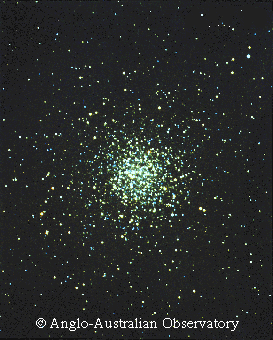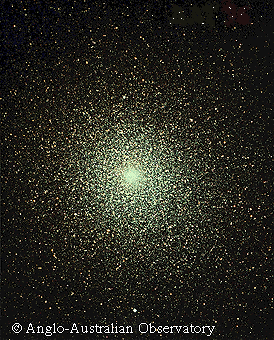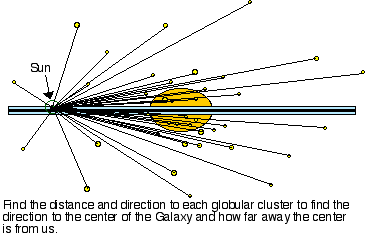 |
 |
This material (including images) is copyrighted!. See my copyright notice for fair use practices. Select the photographs to display the original source in another window. The ground-based telescope pictures here are from the Anglo-Australian Observatory (AAO---used by permission).
In 1918 Harlow Shapley used his calibrated variable star period-luminosity relation to find distances to 93 globular clusters. A globular cluster is a spherical cluster of 100,000's to several million stars (looking like a glob of stars) held strongly together by their mutual gravity force on each other as the cluster moves in a very elliptical orbit around the center of the Galaxy. Two globular clusters are shown below: Messier 5 (in Serpens Caput constellation) and 47 Tucanae (in the southern constellation Tucana).
 |
 |
In the side view picture of the Galaxy at the beginning of this section and below, the globular clusters are represented by the small circles congregating around the bulge of the Galaxy (they have been enlarged over a 100 times to make them visible). Shapley found a strong concentration of globular clusters in the direction of the constellation Sagittarius. In a continuation of the process started by Copernicus almost 500 years before, Shapley announced that our solar system is not at the center of the Galaxy!

If we were at the center of the Galaxy, we would see globular clusters equally distributed all around us. Instead, they congregate around some other point that Shapley calculated to be 32,600 light years from our solar system. He did not know about the dust in the interstellar medium. That discovery was made about a decade later. Taking into account the effects of dust extinction on the brightnesses of stars and also that there are different types of Cepheids, astronomers reduced the solar system's distance to the center of the Galaxy to about 26,000 light years. Trigonometric parallax measurements of star formation regions in 2009 using VLBI measurements fine-tuned that to about 27,000 light years (see also this link and the 2014 update). Our solar system's position is marked with a cross in the pictures of the Galaxy at the beginning of this section.
![]() Go back to previous section --
Go back to previous section --
![]() Go to next section
Go to next section
last updated: June 27, 2022